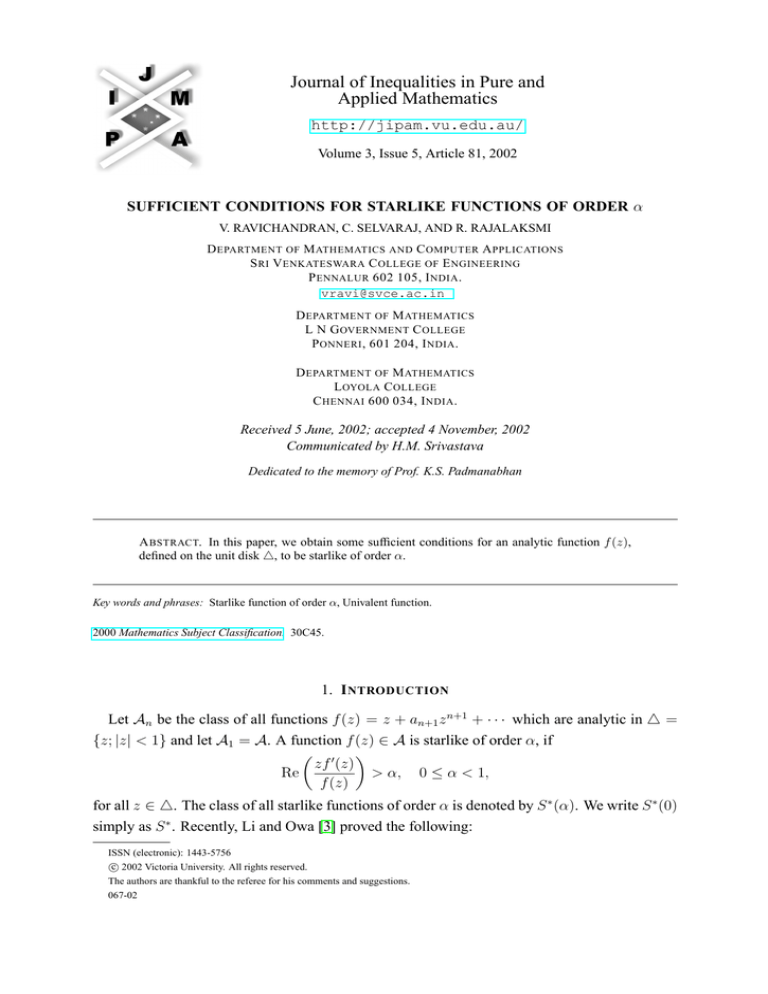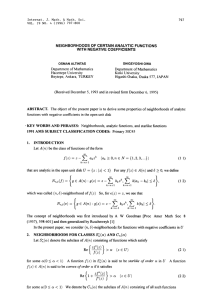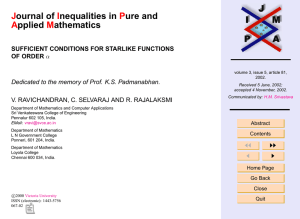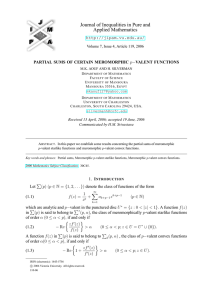
Journal of Inequalities in Pure and
Applied Mathematics
http://jipam.vu.edu.au/
Volume 3, Issue 5, Article 81, 2002
SUFFICIENT CONDITIONS FOR STARLIKE FUNCTIONS OF ORDER α
V. RAVICHANDRAN, C. SELVARAJ, AND R. RAJALAKSMI
D EPARTMENT OF M ATHEMATICS AND C OMPUTER A PPLICATIONS
S RI V ENKATESWARA C OLLEGE OF E NGINEERING
P ENNALUR 602 105, I NDIA .
vravi@svce.ac.in
D EPARTMENT OF M ATHEMATICS
L N G OVERNMENT C OLLEGE
P ONNERI , 601 204, I NDIA .
D EPARTMENT OF M ATHEMATICS
L OYOLA C OLLEGE
C HENNAI 600 034, I NDIA .
Received 5 June, 2002; accepted 4 November, 2002
Communicated by H.M. Srivastava
Dedicated to the memory of Prof. K.S. Padmanabhan
A BSTRACT. In this paper, we obtain some sufficient conditions for an analytic function f (z),
defined on the unit disk 4, to be starlike of order α.
Key words and phrases: Starlike function of order α, Univalent function.
2000 Mathematics Subject Classification. 30C45.
1. I NTRODUCTION
Let An be the class of all functions f (z) = z + an+1 z n+1 + · · · which are analytic in 4 =
{z; |z| < 1} and let A1 = A. A function f (z) ∈ A is starlike of order α, if
0 zf (z)
Re
> α, 0 ≤ α < 1,
f (z)
for all z ∈ 4. The class of all starlike functions of order α is denoted by S ∗ (α). We write S ∗ (0)
simply as S ∗ . Recently, Li and Owa [3] proved the following:
ISSN (electronic): 1443-5756
c 2002 Victoria University. All rights reserved.
The authors are thankful to the referee for his comments and suggestions.
067-02
2
V. R AVICHANDRAN , C. S ELVARAJ , AND R. R AJALAKSMI
Theorem 1.1. If f (z) ∈ A satisfies
0
zf (z)
zf 00 (z)
α
Re
α 0
+1
>− ,
f (z)
f (z)
2
z ∈ 4,
for some α (α ≥ 0), then f (z) ∈ S ∗ .
In fact, Lewandowski, Miller and Zlotkiewicz [1] and Ramesha, Kumar, and Padmanabhan
[7] have proved a weaker form of the above theorem. If the number −α/2 is replaced by
−α2 (1 − α)/4, (0 ≤ α < 2) in the above condition, Li and Owa [3] have proved that f (z) is in
S ∗ (α/2).
Li and Owa [3] have also proved the following:
Theorem 1.2. If f (z) ∈ A satisfies
00
zf (z) zf 0 (z)
< ρ,
−
1
f 0 (z)
f (z)
z ∈ 4,
where ρ = 2.2443697, then f (z) ∈ S ∗ .
The above theorem with ρ = 3/2 and ρ = 1/6 were earlier proved by Li and Owa [2] and
Obradovic [6] respectively.
In this paper, we obtain some sufficient conditions for functions to be starlike of order β. To
prove our result, we need the following:
Lemma 1.3. [4] Let Ω be a set in the complex plane C and suppose that Φ is a mapping from
C 2 × 4 to C which satisfies Φ(ix, y; z) 6∈ Ω for z ∈ 4, and for all real x, y such that y ≤
−n(1 + x2 )/2. If the function p(z) = 1 + cn z n + · · · is analytic in 4 and Φ(p(z), zp0 (z); z) ∈ Ω
for all z ∈ 4, then Re p(z) > 0.
2. S UFFICIENT C ONDITIONS FOR S TARLIKENESS
In this section, we prove some sufficient conditions for function to be starlike of order β.
Theorem 2.1. If f (z) ∈ An satisfies
0
h
i h
zf (z)
zf 00 (z)
n
αn i
Re
α 0
+1
> αβ β + − 1 + β −
, z ∈ 4, 0 ≤ α, β ≤ 1,
f (z)
f (z)
2
2
then f (z) ∈ S ∗ (β).
Proof. Define p(z) by
(1 − β)p(z) + β =
zf 0 (z)
.
f (z)
Then p(z) = 1 + cn z n + · · · and is analytic in 4. A computation shows that
zf 00 (z)
(1 − β)zp0 (z) + [(1 − β)p(z) + β]2 − [(1 − β)p(z) + β]
=
f 0 (z)
(1 − β)p(z) + β
J. Inequal. Pure and Appl. Math., 3(5) Art. 81, 2002
http://jipam.vu.edu.au/
S TARLIKE F UNCTIONS
3
and hence
zf 0 (z)
zf 00 (z)
α 0
+ 1 = α(1 − β)zp0 (z) + α(1 − β)2 p2 (z)
f (z)
f (z)
+ (1 − β)(1 + 2αβ − α)p(z) + β[αβ + 1 − α]
= Φ(p(z), zp0 (z); z),
where
Φ(r, s; t) = α(1 − β)s + α(1 − β)2 r2 + (1 − β)(1 + 2αβ − α)r + β[αβ + 1 − α].
For all real x and y satisfying y ≤ −n(1 + x2 )/2, we have
Re Φ(ix, y; z) = α(1 − β)y − α(1 − β)2 x2 + β[αβ + 1 − α]
h nα
i
α
≤ − (1 − β)n −
(1 − β) + α(1 − β)2 x2 + β[αβ + 1 − α]
2
2
α
α(1 − β)
= − (1 − β)n −
(n + 2 − 2β)x2 + β(αβ + 1 − α)
2
2
α
≤ β(αβ + 1 − α) − (1 − β)n
2
n
nα = αβ β + − 1 + β −
.
2
2
Let Ω = w; Re w > αβ β + n2 − 1 + β − nα
. Then Φ(p(z), zp0 (z); z) ∈ Ω and
2
Φ(ix, y; z) 6∈ Ω for all real x and y ≤ −n(1 + x2 )/2, z ∈ 4. By an application of Lemma 1.3,
the result follows.
By taking β = 0 and n = 1 in the above theorem, we have the following:
Corollary 2.2. [3] If f (z) ∈ A satisfies
0
zf 00 (z)
α
zf (z)
+1
>− ,
Re
α 0
f (z)
f (z)
2
z ∈ 4,
for some α (α ≥ 0), then f (z) ∈ S ∗ .
If we take β = α/2 and n = 1, we get the following:
Corollary 2.3. [3] If f (z) ∈ A satisfies
0
zf (z)
zf 00 (z)
α2
Re
α 0
+1
> − (1 − α),
f (z)
f (z)
4
z ∈ 4,
for some α (0 < α ≤ 2), then f (z) ∈ S ∗ (α/2).
In fact, in the proof of the above theorem, we have proved the following: If p(z) = 1+cn z n +
· · · is analytic in 4 and satisfies
Re(α(1 − β)zp0 (z) + α(1 − β)2 p2 (z) + (1 − β)(1 + 2αβ − α)p(z) + β[αβ + 1 − α])
h
i n
αn > αβ β + − 1 + β −
,
2
2
then Re p(z) > 0. Using a method similar to the one used in the above theorem, we have the
following:
J. Inequal. Pure and Appl. Math., 3(5) Art. 81, 2002
http://jipam.vu.edu.au/
4
V. R AVICHANDRAN , C. S ELVARAJ , AND R. R AJALAKSMI
Theorem 2.4. Let α ≥ 0, 0 ≤ β < 1. If f (z) ∈ An satisfies
f (z)
zf 0 (z)
n
Re
α
+1−α
> − α(1 − β) + β,
z
f (z)
2
z ∈ 4,
then
Re
f (z)
> β.
z
As a special case, we get the following: If f (z) ∈ A satisfies
α
Re {f 0 (z) + αzf 00 (z)} > − ,
2
z ∈ 4,
α ≥ 0, then
Re f 0 (z) > 0.
However, a sharp form of this result was proved by Nunokawa and Hoshino [5].
Theorem 2.5. Let 0 ≤ β < 1, a = (n/2 + 1 − β)2 and b = (n/2 + β)2 satisfy (a + b)β 2
< b(1 − 2β). Let t0 be the positive real root of the equation
2a(1 − β)2 t2 + [3aβ 2 + b(1 − β)2 ]t + [(a + 2b)β 2 − (1 − β)2 b] = 0
and
ρ2 =
(1 − β)3 (1 + t0 )2 (at0 + b)
.
β 2 + (1 − β)2 t0
If f (z) ∈ An satisfies
00
zf (z) zf 0 (z)
≤ ρ,
−
1
f 0 (z)
f (z)
z ∈ 4,
then f (z) ∈ S ∗ (β).
Proof. Define p(z) by
(1 − β)p(z) + β =
zf 0 (z)
.
f (z)
Then p(z) = 1 + cn z n + · · · and is analytic in 4. A computation shows that
zf 00 (z)
(1 − β)zp0 (z) + [(1 − β)p(z) + β]2 − [(1 − β)p(z) + β]
=
f 0 (z)
(1 − β)p(z) + β
and hence
zf 00 (z)
f 0 (z)
zf 0 (z)
−1
f (z)
(1 − β)(p(z) − 1)
=
[(1 − β)zp0 (z) + [(1 − β)p(z) + β]2 − [(1 − β)p(z) + β)]]
(1 − β)p(z) + β
≡ Φ(p(z), zp0 (z); z).
J. Inequal. Pure and Appl. Math., 3(5) Art. 81, 2002
http://jipam.vu.edu.au/
S TARLIKE F UNCTIONS
5
Then, for all real x and y satisfying y ≤ −n(1 + x2 )/2, we have
|Φ(ix, y; z)|2
(1 − β)2 (1 + x2 ) = 2
[(1 − β)y − β + β 2 − (1 − β)2 x2 ]2
2
2
β + (1 − β) x
+[2β(1 − β) − (1 − β)]2 x2
=
(1 − β)2 (1 + t)
{[(1 − β)y − β + β 2 − (1 − β)2 t]2
2
2
β + (1 − β) t
+ [2β(1 − β) − (1 − β)]2 t}
≡ g(t, y),
where t = x2 > 0 and y ≤ −n(1 + t)/2. Since
∂g
(1 − β)3 (1 + t)
= 2
[(1 − β)y − β + β 2 − (1 − β)2 t]2 < 0,
∂y
β + (1 − β)2 t
we have
n
g(t, y) ≥ g t, − (1 + t) ≡ h(t).
2
Note that
2 n
2 (1 − β)3 (1 + t)2 n
h(t) = 2
t
+1−β +
+β
.
β + (1 − β)2 t
2
2
Also it is clear that h0 (−1) = 0 and the other two roots of h0 (t) = 0 are given by
2a(1 − β)2 t2 + [3aβ 2 + b(1 − β)2 ]t + [(a + 2b)β 2 − (1 − β)2 b] = 0,
where a = (n/2 + 1 − β)2 and b = (n/2 + β)2 . Since t0 is the positive root of this equation we
have h(t) ≥ h(t0 ) and hence
|Φ(ix, y; z)|2 ≥ h(t0 ).
Define Ω = {w; |w| < ρ}. Then Φ(p(z), zp0 (z); z) ∈ Ω and Φ(ix, y; z) 6∈ Ω for all real x and
y ≤ −n(1 + x2 )/2, z ∈ 4. Therefore by an application of Lemma 1.3, the result follows.
√
If we take n = 1, β = 0, we have t0 =
73−1
36
and therefore we have the following:
Corollary 2.6. [3] If f (z) ∈ A satisfies
00
zf (z) zf 0 (z)
− 1 < ρ,
f 0 (z)
f (z)
where ρ2 =
√
827+73 73
,
288
z ∈ 4,
then f (z) ∈ S ∗ .
R EFERENCES
[1] Z. LEWANDOWSKI, S.S. MILLER AND E. ZŁOTKIEWICZ, Generating functions for some
classes of univalent functions, Proc. Amer. Math. Soc., 56 (1976), 111–117.
[2] J.-L. LI AND S. OWA, Properties of the Salagean operator, Georgian Math. J., 5(4) (1998), 361–366.
[3] J.-L. LI AND S. OWA, Sufficient conditions for starlikeness, Indian J. Pure Appl. Math., 33 (2002),
313–318.
[4] S.S. MILLER AND P.T. MOCANU, Differential subordinations and inequalities in the complex
plane, J. Differ. Equations, 67 (1987), 199–211.
J. Inequal. Pure and Appl. Math., 3(5) Art. 81, 2002
http://jipam.vu.edu.au/
6
V. R AVICHANDRAN , C. S ELVARAJ , AND R. R AJALAKSMI
[5] M. NUNOKAWA AND S. HOSHINO, One criterion for multivalent functions, Proc. Japan Acad.,
Ser. A, 67 (1991), 35–37.
[6] M. OBRADOVIĆ, Ruscheweyh derivatives and some classes of univalent functions, in: Current
Topics in Analytic Function Theory, (H.M. Srivastava and S. Owa, Editors), World Sci. Publishing,
River Edge, NJ, 1992, pp. 220–233.
[7] C. RAMESHA, S. KUMAR AND K.S. PADMANABHAN, A sufficient condition for starlikeness,
Chinese J. Math., 23 (1995), 167–171.
J. Inequal. Pure and Appl. Math., 3(5) Art. 81, 2002
http://jipam.vu.edu.au/












